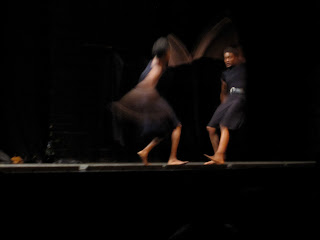Kettly Noel (l) and Nelisiwe Xaba (r)
On Friday night some friends and I, after eating pumpkin soup on my roof under a nearly full moon, attended Kettly Noel (Mali, Haiti) and Nelisiwe Xaba (South Africa)'s choreographed contemporary dance piece "Correspondances" at the French Cultural Center. All I knew about the performance before I entered the theater was that it was about women meeting each other in different places. The blurb on the Center's website did not prepare me for what I saw. Nelisiwe enters through a curtain covered doorway in the middle of the stage. She wears a black and white flower-patterned trench coat and staggering stiletto heels. Behind her and to the left is a row of hanging, black suit bags and matching black sacks on the floor. She begins to describe her morning routine, in English and with her body, the places in her home where she checks out her outfit, make-up and hair each morning before heading out into the fray. She says if she's going to have men craning their necks to look at her - she wants to give them something good to look at.

Setting the scene
Then, Kettly announces her presence on the scene, breaking Nelisiwe's mirrors-in-the-morning monologue, from a balcony upstairs. She's wearing a short skirt and carries a briefcase like you'd imagine a flapper in the 1920s holding at a train station. She floats downstairs and starts giving bisoux to folks in the crowd, waving as though they're old friends and then climbs onstage, sets down her suitcase and steps to the back of the stage for a costume change. While Nelisiwe performs a dance with a 2 ft high doll pulled from Kettly's suitcase, Kettly non-chalantly changes into a black dress and a new pair of heels in the background, a simple black leotard on underneath which, while just like a bathing suit, is extremely shocking in conservative Mali. I'm not used to seeing anyone else's legs but my own! The two proceed to simulate a club atmosphere and their bodies speak not only to one another on the stage, asking and answering in a rapid-fire succession, but also to the audience as we imagine ourselves or others in a dance-club. The two begin to hip-bump - playfully at first and then violently - as they compete for the attention of an absent man.

Can you do this?
While Nelisiwe changes, Kettly pulls a microphone into the middle of the stage and begins a feminist monologue. She lists her womanly attributes in emphatic French. Sensulle. Oui. Sexuelle. Oui. Sensitive. Oui. Soumise*. Non. Interessante. Oui. Belle. Oui. Je suis une femme globale, oualie! Then, she speaks about the state of Africa in the world and Anglophonie and Francophonie and asks us when will we start talking about Afriphonie? (one of my favorite parts of the show). She ends the monologue by dragging the mike-stand off stage, verbally asserting her sensuality, as she burps loudly into the microphone.The dance ended with an interesting statement on, well...it's hard to say. It was a little graphic, mildly messy and a whole lotta confusing. All I can say is check out the artists on YouTube if you're interested in learning and seeing more. Throughout the performance Kettly and Nelisiwe coupled vehement social statements with satire, using their bodies and words, concerning Africa, women, friendships, love and politics for a dance performance that left me in awe of the capabilities of the human body and shaking my head at the meaning of it all. Three days later I'm still talking about the performance with the folks I went to the show with and am looking forward to the Danse L'Afrique Danse! biennial in Bamako next week.

Post-show - two medical gloves and a stage of fake milk...
*Submissive





















